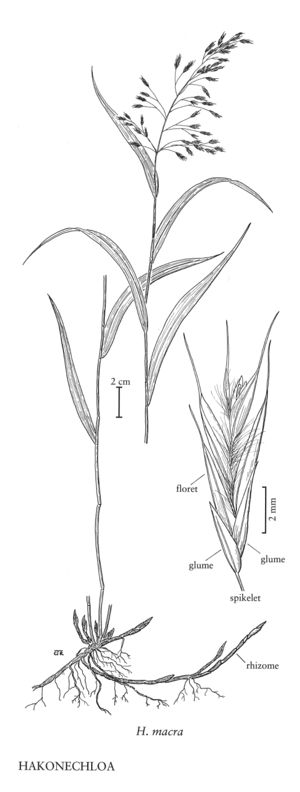Difference between revisions of "Hakonechloa macra"
FNA>Volume Importer |
imported>Volume Importer |
||
| (4 intermediate revisions by 2 users not shown) | |||
| Line 17: | Line 17: | ||
-->{{Treatment/Body | -->{{Treatment/Body | ||
|distribution=Utah | |distribution=Utah | ||
| − | |discussion=<p>In Japan, Hakonechloa macra grows on rocks along rivers. Although rhizomatous, it is not an invasive species and is recommended for mass planting. Three forms are cultivated: forma alboaurea Makino ex Ohwi, with white- and yellow-striped leaves; forma albovariegata Makino ex Ohwi, with white-striped leaves; and forma aureola Makino ex Ohwi, with yellow leaves having narrow green stripes. This last form is the one most commonly available in the Flora region.</p> | + | |discussion=<p>In Japan, <i>Hakonechloa macra</i> grows on rocks along rivers. Although rhizomatous, it is not an invasive species and is recommended for mass planting. Three forms are cultivated: forma alboaurea Makino ex Ohwi, with white- and yellow-striped leaves; forma albovariegata Makino ex Ohwi, with white-striped leaves; and forma aureola Makino ex Ohwi, with yellow leaves having narrow green stripes. This last form is the one most commonly available in the Flora region.</p> |
|tables= | |tables= | ||
|references= | |references= | ||
| Line 26: | Line 26: | ||
-->{{#Taxon: | -->{{#Taxon: | ||
name=Hakonechloa macra | name=Hakonechloa macra | ||
| − | |||
|authority=(Munro) Makino | |authority=(Munro) Makino | ||
|rank=species | |rank=species | ||
| Line 33: | Line 32: | ||
|basionyms= | |basionyms= | ||
|family=Poaceae | |family=Poaceae | ||
| − | |illustrator=Linda A. Vorobik | + | |illustrator=Linda A. Vorobik;Cindy Roché |
| + | |illustration copyright=Utah State University | ||
|distribution=Utah | |distribution=Utah | ||
|reference=None | |reference=None | ||
| Line 39: | Line 39: | ||
|publication year= | |publication year= | ||
|special status= | |special status= | ||
| − | |source xml=https:// | + | |source xml=https://bitbucket.org/aafc-mbb/fna-data-curation/src/200273ad09963decb8fc72550212de541d86569d/coarse_grained_fna_xml/V25/V25_20.xml |
|subfamily=Poaceae subfam. Arundinoideae | |subfamily=Poaceae subfam. Arundinoideae | ||
|tribe=Poaceae tribe Arundineae | |tribe=Poaceae tribe Arundineae | ||
Latest revision as of 17:58, 11 May 2021
Rhizomes and stolons covered with pale, coriaceous scales. Culms 30-90 cm tall, 1-1.5 mm thick, glabrous. Adaxial ligules 0.2-0.3 mm; blades 8-25 cm long, 0.4-1.2 cm wide, glabrous, abaxial surfaces green, adaxial surfaces often paler, turning orange-bronze in the fall. Panicles 6-12 cm long, 5-7 cm wide, open, nodding, with 15-30 spikelets; branches paired, somewhat stiff, scabrous. Spikelets 1-2 cm, yellowish-green, with 5-10 florets. Glumes broadly lanceolate; lower glumes 3-4 mm, 1-3-veined; upper glumes 3.8-5 mm, 3-veined; calluses 1.5-2 mm, strigose, hairs 1-1.5 mm; lemmas 6-7 mm long, 1.8-2.2 mm wide, chartaceous, 3-veined, margins sparsely pilose with long papillose-based hairs near the base, awned; awns 3-5 mm; anthers 2-3 mm. Caryopses about 2 mm. 2n = 50.
Discussion
In Japan, Hakonechloa macra grows on rocks along rivers. Although rhizomatous, it is not an invasive species and is recommended for mass planting. Three forms are cultivated: forma alboaurea Makino ex Ohwi, with white- and yellow-striped leaves; forma albovariegata Makino ex Ohwi, with white-striped leaves; and forma aureola Makino ex Ohwi, with yellow leaves having narrow green stripes. This last form is the one most commonly available in the Flora region.
Selected References
None.
